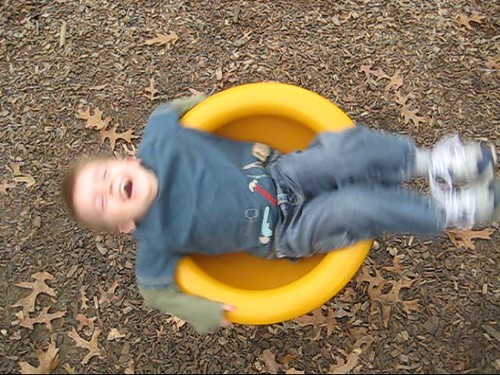
By: andrechinn
What is Stimming?
Have you ever felt so anxious that you started shaking or bouncing your legs, or biting your nails? Have you ever gotten up from studying to walk around a couple of minutes to focus better? Do you feel that you are unusually jumpy, nervous, or jittery for no identifiable reason, which forces you to twirl your hair or pick at your skin? If you can answer yes, then you have stimmed. |
Self-stimulatory behaviors or stimming are motor, verbal, visual, tactile, or olfactory repetitive behaviors that individuals use as sensory stimuli to regulate emotions or to more comfortably communicate with others. Some examples of stimming are:
- Rocking the body back and forth
- Rubbing the skin
- Biting nails
- Spinning in circles
- Clapping hands
- Repeating sounds
- Tapping your foot or your fingers in the desk
- Smelling objects repetitively
Why Autistic Individuals Stim?
Stimming is a topic that has been controversial for years in the autism world. Many clinicians, teachers, and parents have seen stimming behaviors as a problem in autistic individuals. However, currently, reliable studies and many scholars and professionals, support stimming behaviors as beneficial for the autistic population and have identified similar behaviors in the non-autistic population, as well.
In this video, the Director of Child Development at Mount Sinai Beth Israel, Alma Sadiq, M.D. explains that stimming is a common behavior in autistic children. She states that children with autism can present with stimming behaviors due to anxiety, overstimulation or to communicate their feelings. She states that children can often engage in stim behaviors to calm themselves, or when they are overexcited and cannot self-regulate. Sadiq also explains that autistic children engage in both verbal and nonverbal stimming. However, a lot of stimming behaviors are body movements like shaking a toy repeatedly or spinning in circles. Also, Sadiq explains the difference between stimming and motor tics. She states that “A child can be blinking or have facial grimacing, or can be smacking their lips or making sounds. These are tics. They could be motor or vocal tics and these are different from stimulating behaviors.”
Sadiq finishes by stating that it is important to analyze when the child engages in stimming behaviors and to understand the reasons for engaging in those behaviors. For example; children are stimming because they feel overloaded with the stimuli in their surroundings or maybe because they ate something they did not like and are trying to communicate that to you. Sadiq concludes by saying stimming is a method that helps autistic children to communicate or to simply calm themselves down when overexcited. Stimming is a self-stimulatory behavior that is common in people with autism spectrum disorder (ASD).
In this video clip, Philip Fizur, M.D. underscores that stimming is a behavior that is used by autistic individuals to manage stimuli levels in the environment to help soothe. The video clip also states that stimming is part of the diagnostic criteria for ASD. However, autistic individuals do this in a way that can be socially disruptive. The video clip also mentions the reasons why autistic and non-autistic people stim, such as regulating stress and emotions and helping with sensory processing or social communication.
Fizur also states that individuals use stimulatory behaviors like hand flapping to shut out external stimuli that can be caused by overwhelming environments and are more commonly used by autistic individuals. When autistic individuals receive too much information from their surroundings, they may not know how to react, so they use stimming to relieve the overstimulation and emotional excitation caused by stress and anxiety. According to Fizur, verbal communication can be challenging in autistic individuals, so stimming helps them communicate their feelings and needs. For example, when autistic kids are extremely happy, they show you by repeatedly clapping their hands or repeatedly jumping up and down. Similarly, autistic individuals use types of stimming to let you know the food that they cannot tolerate because of flavor or texture.
According to the video clip, there is not a specific reason why stimming makes people feel good but the behavior helps activate the chemicals in the brain that regulate our emotions. The video also mentions that in the past clinicians believed that autistic stimming behaviors needed to be stopped or “fixed.” However, recent studies state that if the stim is unharmful, individuals should be allowed to do it because it can be highly beneficial.
What do Autistic Individuals Think About Stimming?
“Stimming is like breathing… Just as natural, just as important.”
(The mighty, 2016)
In this video clip, various autistic individuals share their thoughts about how they feel when stimming. They reveal that stimming refreshes their minds, helps them deal with negative emotions, relieves tension and stress, and provides them with calmness. Stimming also allows them to focus and provides them with joy and excitement, making them feel incredibly happy and enthusiastic about the outer world they are exploring. In the video, one of the participants explains that trying to stop stimming behaviors feels unpleasant for autistic individuals, such as themselves.
We all Should Stim!
As an occupational therapy assistant with a background in early childhood education, I have seen stimming behaviors not only in individuals with neurodevelopmental conditions but also in neurotypical individuals.

By: Filip Pticek
In all the video clips, stimming can be seen as beneficial to autistic and non-autistic individuals. The various authors believe we all should stim! The authors asserted that non-autistic persons also stim, but it only seems disruptive to others when autistic persons do it. Stimming releases emotions and energy, helps regulate sensory stimuli in the surrounding and as a way to communicate feelings. I have stimming behaviors! I do it to focus better when I am studying. I have come to realize that I cannot stay sitting for too long, so I got a desk that I can move up and down so that I can study sitting or standing up. I added wheels to the desk, so I can move around my apartment in case I feel overwhelmed, and I want to change my environment. And you? Do you stim?
| Consider that something as simple as the fidgeting we may see in non-autistic people has a lot in common with stimming in autism. Therefore, we should collectively promote a greater understanding of these kinds of repetitive behaviors, not just for the ASD population but for the rest of us who also share various types of self-soothing habits. |
References
Health Magazine. (2020, December 27). What is stimming? symptoms of anxiety and self-stimulation. [Video]. YouTube. https://www.youtube.com/watch?v=F5H17FHYa-k&t=66s
Howcast. (2015, January 30). What is stimming? Autism. [Video]. YouTube. https://www.youtube.com/watch?v=xTBb3p8JF44
Kapp, S. K., Steward, R., Crane, L., Elliott, D., Elphick, C., Pellicano, E., & Russell, G. (2019). “People should be allowed to do what they like”: Autistic adults’ views and experiences of stimming. Autism: The International Journal of Research & Practice, 23(7), 1782–1792. https://doi.org/10.1177/1362361319829628.
Mays, N. M., Beal-Alvarez, J., & Jolivette, K. (2011). Using movement-based sensory interventions to address self-stimulatory behaviors in students with autism. Teaching Exceptional Children, 43(6), 46–52. https://doi.org/10.1177/004005991104300605.
McCormack, L., Wong, S. W., & Campbell, L. E. (2022). ‘If I don’t do it, I’m out of rhythm and I can’t focus as well’: Positive and negative adult interpretations of therapies aimed at ‘fixing’ their restricted and repetitive behaviours in childhood. Journal of Autism & Developmental Disorders, 1–14. https://doi.org/10.1007/s10803-022-05644-6.
Nagel, A. (2020, September 22). Stimming to connect, relieve stress and cope with a pandemic. Autism Speaks. https://www.autismspeaks.org/life-spectrum/stimming-connect-relieve-stress-and-cope-pandemic.
Rudy, L. J. (2022, July 24). What Is stimming? Repetitive behaviors or noises often associated with autism. Very Well Health. https://www.verywellhealth.com/what-is-stimming-in-autism-260034#citation-4.
The Mighty. (2016, May 9). People with autism explain what stimming feels like. [Video]. YouTube. https://www.youtube.com/watch?v=xTBb3p8JF44
